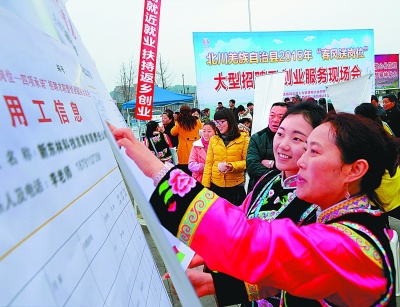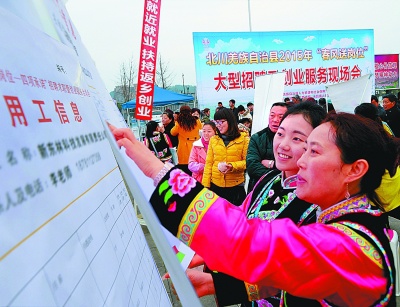By Bai Long from People’s Daily

China has given its people a “sense of gain” by delivering a range of progressive achievements through increased reforms in many ways over the past five years.
For one thing, it is one of the safest countries in the world, according to the global crime and safety index for 2016, or in the words of two foreigners living here, “China is so safe that I’ve told my parents that I will stay here for good.”.
This comes from a documentary, "Amazing China", which describes the innovations, greening, opening up and inclusiveness China has seen since the 18th National Congress of the Communist Party of China (CPC), in 2012.
In addition to the social security, China has made steady progress in reforming several sectors that affect people’s lives, over the past five years, for instance, from 2014 to 2016, it registered around 13.6 million new enterprises, with an annually increase of 30 percent.
In another example, amount of people’s payments for national healthcare dropped from 34.8 percent in 2011 to 28.8 percent in 2016, the lowest level for the past 20 years.
The standard of living, meanwhile, has improved, with annual incomes of both urban and rural people growing by 7.4 percent on average since 2013, practically in line with the country’s GDP growth.
China’s Gini coefficient, an index for measuring the gap between rich and poor, fell from 0.473 in 2013 to 0.465 in 2016, considerable achievements that reflect a real “sense of gain” among the 1.3 billion people.
President Xi Jinping has pointed out that the real way to measure the results of any reforms are the success of the economy and the feeling of a greater sense of gain among the people. And, it’s fair to say that these are a good guide to measure the effects of China’s great reform drive over these many years.
According to, The Fourth Revolution: The Global Race to Reinvent the State, written by two editors from The Economist, about 240 million rural Chinese have been able to take part in the country’s pension insurance system, in only two years, exceeding the total population under the similar system in the US.
Many foreign politicians and analysts attribute China’s dynamic political system and healthy development to this increase in reforms overall, and say it has greatly affected Chinese society and provided a better environment for people to live and develop in.
In the past five years, the country has come up with many measures for eliminating poverty, or for reforming the judicial, finance, taxation, household registration, education, rural land, public hospital, and other systems. These reforms are closely related to people’s lives and all have the purpose of boosting that sense of gain among the Chinese.
The true secret of China’s developmental vitality is in applying these reforms by constantly considering people’s expectations and allowing the reforms to provide the necessary impetus for development.
In those five years, the number of Chinese students returning to the motherland after finishing their studies abroad has increased, bringing the largest wave of returning students in the entire century. At the same time, the number of foreign scientists, engineers, and managers attracted to China has been growing as well.
Those people returning, came back to find the country undergoing real changes, something that can easily be seen in the mobile payments that make shopping easier, shared bicycles that make travel greener and more convenient, and the growth in e-commerce, as well as the expanded high-speed railway network and the Fuxing bullet trains that breeze along at 350 kilometers per hour.
There you have it, a thriving economy, safe living conditions, and more convenient life, all of which are making people more convinced of the positive changes and the new impetus for development resulting from the overall reforms.
For one thing, it is one of the safest countries in the world, according to the global crime and safety index for 2016, or in the words of two foreigners living here, “China is so safe that I’ve told my parents that I will stay here for good.”.
This comes from a documentary, "Amazing China", which describes the innovations, greening, opening up and inclusiveness China has seen since the 18th National Congress of the Communist Party of China (CPC), in 2012.
In addition to the social security, China has made steady progress in reforming several sectors that affect people’s lives, over the past five years, for instance, from 2014 to 2016, it registered around 13.6 million new enterprises, with an annually increase of 30 percent.
In another example, amount of people’s payments for national healthcare dropped from 34.8 percent in 2011 to 28.8 percent in 2016, the lowest level for the past 20 years.
The standard of living, meanwhile, has improved, with annual incomes of both urban and rural people growing by 7.4 percent on average since 2013, practically in line with the country’s GDP growth.
China’s Gini coefficient, an index for measuring the gap between rich and poor, fell from 0.473 in 2013 to 0.465 in 2016, considerable achievements that reflect a real “sense of gain” among the 1.3 billion people.
President Xi Jinping has pointed out that the real way to measure the results of any reforms are the success of the economy and the feeling of a greater sense of gain among the people. And, it’s fair to say that these are a good guide to measure the effects of China’s great reform drive over these many years.
According to, The Fourth Revolution: The Global Race to Reinvent the State, written by two editors from The Economist, about 240 million rural Chinese have been able to take part in the country’s pension insurance system, in only two years, exceeding the total population under the similar system in the US.
Many foreign politicians and analysts attribute China’s dynamic political system and healthy development to this increase in reforms overall, and say it has greatly affected Chinese society and provided a better environment for people to live and develop in.
In the past five years, the country has come up with many measures for eliminating poverty, or for reforming the judicial, finance, taxation, household registration, education, rural land, public hospital, and other systems. These reforms are closely related to people’s lives and all have the purpose of boosting that sense of gain among the Chinese.
The true secret of China’s developmental vitality is in applying these reforms by constantly considering people’s expectations and allowing the reforms to provide the necessary impetus for development.
In those five years, the number of Chinese students returning to the motherland after finishing their studies abroad has increased, bringing the largest wave of returning students in the entire century. At the same time, the number of foreign scientists, engineers, and managers attracted to China has been growing as well.
Those people returning, came back to find the country undergoing real changes, something that can easily be seen in the mobile payments that make shopping easier, shared bicycles that make travel greener and more convenient, and the growth in e-commerce, as well as the expanded high-speed railway network and the Fuxing bullet trains that breeze along at 350 kilometers per hour.
There you have it, a thriving economy, safe living conditions, and more convenient life, all of which are making people more convinced of the positive changes and the new impetus for development resulting from the overall reforms.
 Menu
Menu
 China’s reforms mean a stronger ‘sense of gain’ among its people
China’s reforms mean a stronger ‘sense of gain’ among its people
















